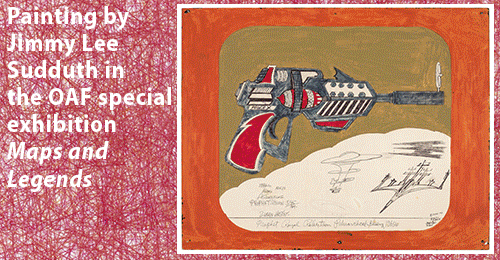
AN INSIDE LOOK AT SOME OF THE HIGHLIGHTS AND BIG DISCOVERIES TO COME
by Edward M. Gómez
Art, that great soother of the soul. Art, that self-contained place of refuge and provider of a path — and rewarding destination — for spirit-lifting great escapes.
After two years of pandemic-provoked isolation and confinement, some cities and regions are beginning to emerge, cautiously, from the strict conditions the seemingly endless virus crisis has imposed. Thank you, science, for wonder-drug vaccines, and big thanks to all the members of the human family who have looked beyond the lies and selfishness of the anti-vax crowd to roll up their sleeves, get vaccinated, and make the world a safer place for everyone.

Now, for the virus-weary, the Outsider Art Fair, with all its color, imagination, bold gestures, and defiant expressions proposing just how far-out art can be, will soon be back in full form, offering a mid-winter tonic to art lovers starved for the kind of nourishment for the mind and the soul no Uber Eats messenger can deliver.
This year, the 2022 OAF New York will take place at its usual location in the Chelsea district of downtown Manhattan (Metropolitan Pavilion, 125 West 18th Street) from Thursday, March 3 through Sunday, March 6. While last year’s pandemic conditions led the fair to take the form of an online event combined with several in-person exhibitions mounted at various Manhattan venues, this year’s production will feature the usual confab of dealers and other representatives from the related fields of art brut and outsider art, including exhibitors from the United States and overseas.
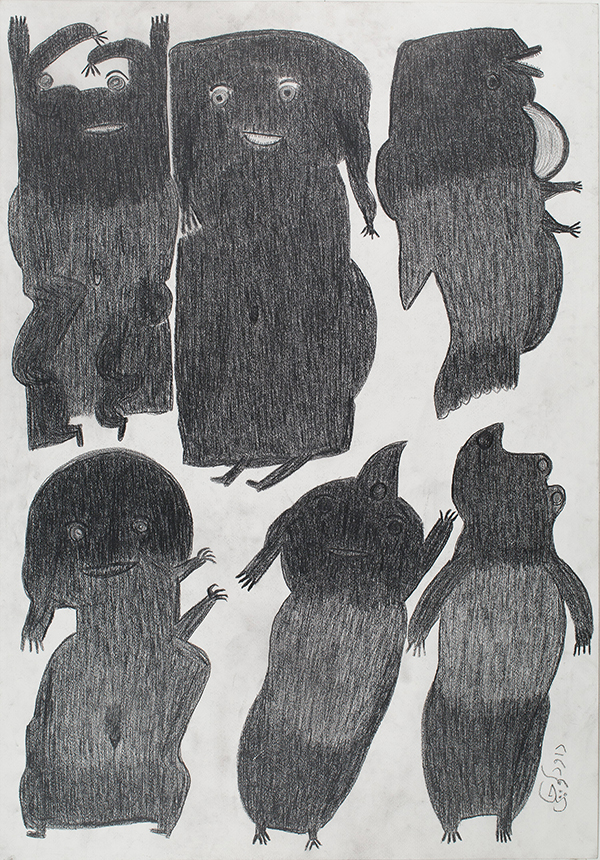
Also within this year’s fair, four special, thematic exhibitions will be presented, including Beyond Genres: Self-Taught Artists Making Contemporary Art, curated by Paul Laster, featuring works that may be seen as residing somewhere in a fuzzy zone between the outsider and contemporary-art categories, and a survey of the creations of the clay-animation artist Bruce Bickford (1947-2019). Bickford was a longtime collaborator of the prolifically experimental musician, composer, and bandleader Frank Zappa (1940-1993). This show is being assembled by the contemporary painter Eric White and the filmmaker Aaron Guadamuz.
advertisement
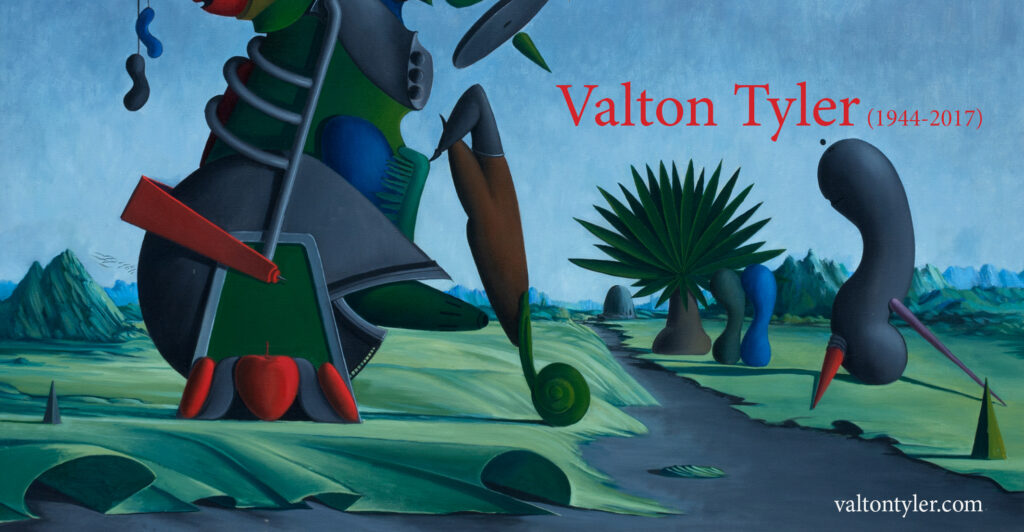
Meanwhile, the contemporary artist Fred Tomaselli is organizing Field Trip: Psychedelic Solution, 1986-1995, an exhibition showcasing the far-out productions of such artists as Joe Coleman, Bruce Conner, Robert Crumb, and Gary Panter, among others. Field Trip will feature works from the personal collection of Jacaeber Kastor, the founder and director of Psychedelic Solution Gallery, which operated in downtown Manhattan’s Greenwich Village neighborhood from 1986 to 2004.
Phillip March Jones, an independent curator and the founder of the new March Gallery, in the East Village, is a former director of the Atlanta-based Souls Grown Deep Foundation; for this year’s OAF, he is assembling an exhibition of works from the collection of Michael Stipe, the lead vocalist of the rock band R.E.M., whose founding members were all students at the University of Georgia in Athens. Jones is a longtime specialist in the art of self-taught artists from the American South, which Stipe has collected, including, for example, paintings by the late Howard Finster.
The 2022 OAF comes at a time when many dealers, collectors, and other art-market players have become familiar with examining — and buying and selling — works of art solely on the strength of photos perused online, and when numerous blue-chip contemporary-art galleries have become increasingly and very visibly involved in the handling of outsider art. While offering the excitement of a full-fledged art-fair experience, which no online presentation can rival, this year’s OAF must also satisfy experienced collectors who will be eager to make some big discoveries and expand their current holdings with works that will feel fresh and promise the potential for increased investment value to come.

What have the outsider art field’s most inveterate dealer-sleuths dug up since the OAF’s last in-person edition took place two years ago?
In the lead-up to the fair, brutjournal spoke with several dealers who will be participating in this year’s event. They shared with us some of the new finds and rarities they’ll be presenting this year.
Randall Morris, who, along with Shari Cavin, co-founded New York’s Cavin-Morris Gallery in 1985, represents a generation of dealer-collectors who, over the years, have played significant, influential roles in the fostering of what has become today’s lively, specialized market for the works of self-taught artists. Alluding to the online experience of just about everything that has characterized the long pandemic period, Morris said, “There is no perfect substitute for being in the physical presence of actual art. We can buy online, because we can fill in particulars [in an art collection] from experience and, thus, come to the Web with a certain amount of foreknowledge. But especially with a work of art’s textures and dimensional nuances, seeing it in person is best.”
Morris added, “I expect a very upbeat, perhaps even chaotic fair. There is an enormous amount of interest in this field right now. However, I don’t think there will be any particular kind of art that [may be seen as] ‘responding’ to the current moment. Life goes on. One can only hope that attention will be paid to self-education and quality.”
Among other works, Cavin-Morris will show new drawings in pencil and colored pencil by the Japanese artist Monma, whose refined technique allows him to create the dramatic illusion of dynamic, layered depths in his pictures, in which mysterious phantoms bob and congregate like elusive, underwater creatures. Luscious, too, and equally liquid within their pictorial space, are the ectoplasmic-abstract, mixed-media-on-paper compositions of Izabella Ortiz, with whom the gallery has worked for several years.
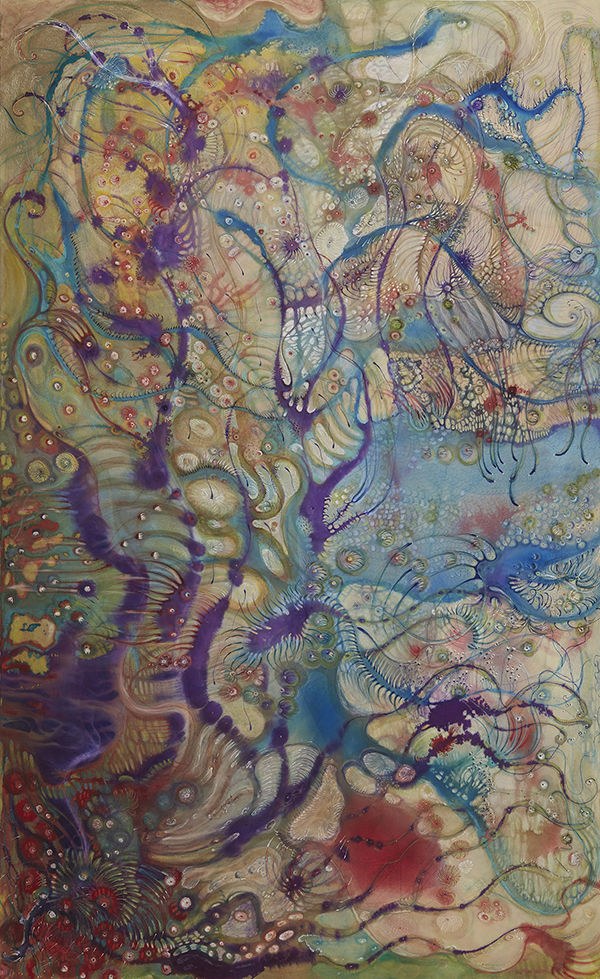
Ortiz’s images have become ever more complex. They’re filled with colors and organic forms in constant motion. Ortiz has written, “My mother is Australian, and my father French-Colombian, and, as a child, I lived in France, Australia, and also Alaska. My painting is impregnated with Inuit, Aboriginal, and Indian myths, tales, and legends.” Her pictures’ titles often refer to memories or dreams. Cavin-Morris will also show drawings of animal-like forms in pencil on paper by the Iranian artist Davood Koochaki, who died in 2020.
From Chicago, Carl Hammer Gallery, another venerable outpost, will offer works by several artists in American outsider art’s canon, including Bill Traylor, Henry Darger, Joseph Yoakum, Eugene Von Bruenchenhein, and Lee Godie. One Godie drawing from Hammer is a particular gem; it shows a woman in sharp profile sporting a wide-brimmed, Garbo-worthy hat, its opposite-side rim folded back perpendicularly at an improbable angle, making the face of the artist’s subject appear to be trapped in some kind of diagram of planetary orbits.
So who needs strict two-point perspective anyway? Love the extravagances of the outsider imagination!
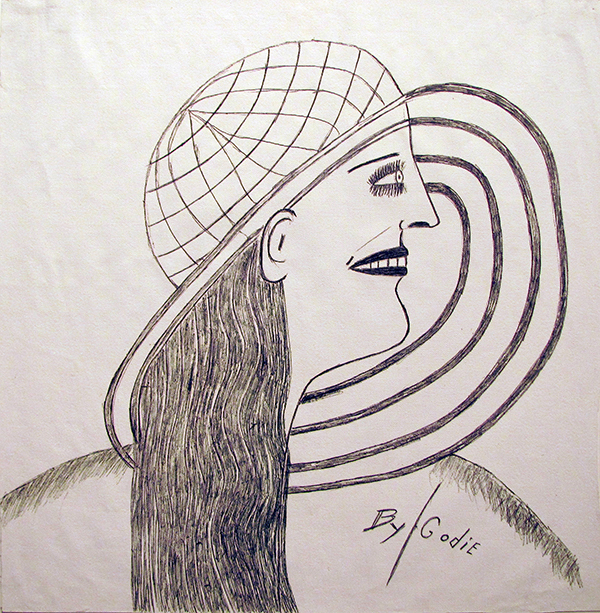
The New York dealer Marion Harris will show paintings by the Canadian artist Claude Bolduc (born 1955), which are packed with big-eyed creatures frolicking in restless, fantastical scenes. As the Canadian researcher Linda Rainaldi has pointed out (see her report about the Canadian self-taught painter Menno Krant in brutjournal’s November 2021 issue), Bolduc was an admirer of the work of Arthur Villeneuve (1910-1990), another autodidact from his native Québec, who believed he was the reincarnation of the painter Henri Rousseau.
Bolduc once said, “From 1987 to 1990, I painted often, until exhaustion. It was liberating for me. I did not care about the derogatory or ridiculing comments I received from those around me. I just locked myself in a room and devoted all my free time to painting.” Love the outsider sense of determination and commitment, too!
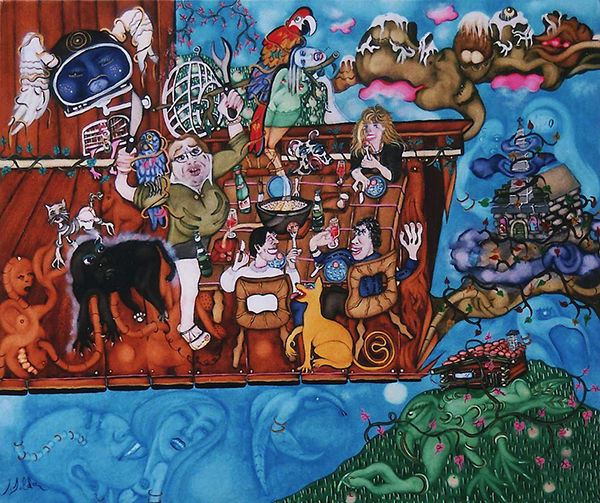
From Marseille, the Mediterranean port city in the south of France, Galerie Polysémie will feature recent works by the iconic French art brut creator André Robillard, who celebrated his 90th birthday late last year. (See our article about Robillard in brutjournal’s January 2022 issue.) Polysémie director François Vertadier has worked closely with Robillard for many years. At this year’s OAF, he will show large drawings the artist has executed on sheets and towels from the psychiatric hospital in north-central France with which he has been associated for many years and on whose property he lives and works in his own home.

Vertadier will also present new collage works by Anne Marie Grgich and the dense architectural compositions, depicting real and imaginary cities, of his latest find, the artist David Mazin (born 1972), who is based in the Marseille region. Vertadier says, “He creates his own universe. Mazin’s art — this is the kind of discovery I love to make.”
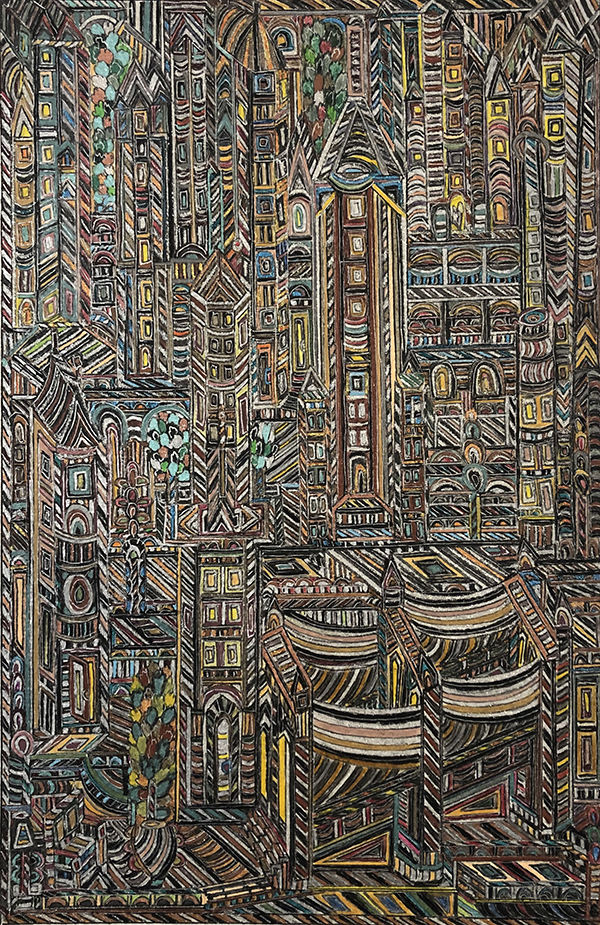
The Brooklyn-based LAND Gallery, which shows the creations of participants in its studio program for adult artists with developmental disabilities, will feature works by Byron Smith, Christine Lewis, and Robert Latchman, among others. Look for Smith’s neatly outlined, flatness-emphasizing pictures in colored pencil on paper of men, women, or couples, some with big eyes and long, long, long eyelashes. All of their faces are richly expressive.
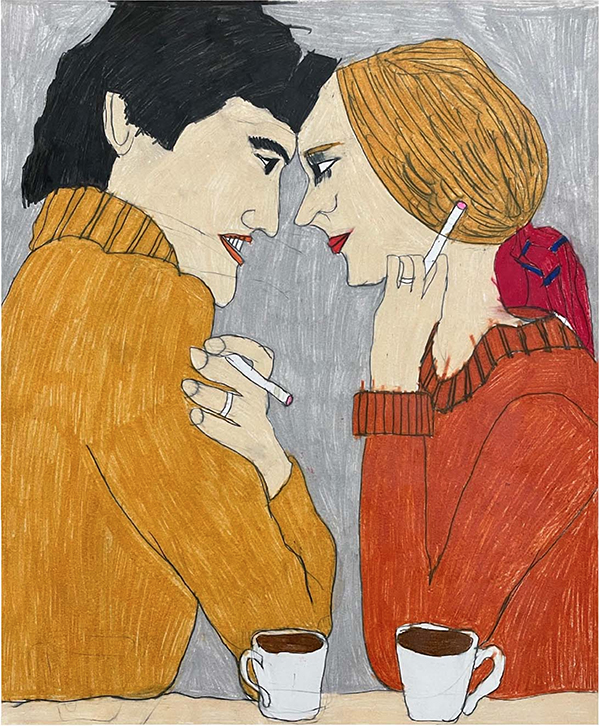
Matthew Murphy, a LAND Gallery co-founder and the organization’s curator, told us, “Art is meant to be encountered and pondered in a give-and-take relationship that only can be promised in person.” The OAF, he noted, “allows for a breaking down of barriers” as it makes room on the broader art world’s radar screen for a range of self-taught art-makers’ expressions, without adhering to “strict definitions of movements or trends.”
Coming from Houston, the longtime curator Bill Arning, who now operates his own gallery, Bill Arning Exhibitions, in that city, will feature new, unusual works made by the artist Wayne Gilbert (born 1947), which were produced using ash from cremated human remains. Gilbert has been active on Houston’s art scene for many decades, as a member of the multidisciplinary Rubber Group, a curator, and the founder of art-presenting venues of his own.
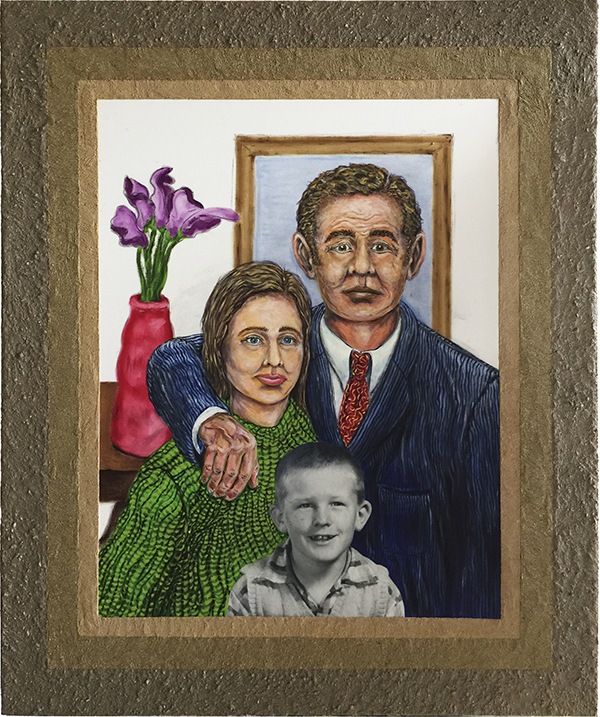
Describing Gilbert’s working method, a fact sheet issued by Arning’s gallery explains, “On receiving a packet of ash, Gilbert sorts the particles into colors — there is a great variety of whites, blacks, grays, and browns that come out of the cremation process.” Then the artist decides what the image he will create will depict, “always focus[ing] on his iconography of mortality, which, one can argue, is often the substance of great art.”
Arning, who refers to Gilbert as “a wise old soul who deals with life or death issues with poetic, gallows humor,” pointed out that the artist plans to be present in his gallery’s booth frequently during the run of the fair. “Few visitors will forget meeting him,” Arning advised.
Steven S. Powers Works of Art & Americana, a gallery located on Manhattan’s Lower East Side, will bring a batch of what might turn out to be some of the most charming and, in a quiet way, deliciously subversive drawings to appear at this year’s OAF. They’re the handiwork of Edwin Lawson (1911-1980), an architecture professor at the University of Cincinnati who, in his brightly colored pictures made with crayon and pencil on paper, portrayed himself dressed up in women’s fashions from the 1880s through the 1960s. Apparently, his wife was unaware of his art-making or of the cross-dressing fantasies that inspired them.

Dealer Steven S. Powers told us, “Lawson heavily worked his drawings, struggling to correct certain details he dreamed about, like his made-up eyes, lips, jewelry, and bosom. In the 1960s and 1970s, drag culture was becoming less underground. On the alternative arts and fashion scenes, figures like Divine, music by David Bowie and Marc Bolan, and movies like The Rocky Horror Picture Show brought gender-bending more into the zeitgeist.” Still, Powers noted, that emerging tendency in certain precincts of pop culture still “did not mean that it had become mainstream and culturally safe.” Powers assumes that “Lawson probably felt inspired by the drag scene but still too uncomfortable to fully manifest his sexual identity at a time when it would likely have threatened his relationships and his career.”
From a very different creative corner, Powers will also show large, carved wooden figures made by Charles Jarm (1932-2021), a gay, Chinese-American artist who lived in Manhattan’s Chinatown during the 1970s. Archival photographs of Jarm at work show him naked, chiseling his nude subjects out of chunks of wood lying flat on the floor of his apartment. This artist’s work was unknown until recently; it’s ready and waiting for serious scholars to start examining and bringing forward into the broader art history of its time.

From Boise, Idaho, Stewart Gallery will show the finely crafted, mixed-media works of Stephanie Wilde, whose components include drawing, painting, ink, acrylic paint, and gold leaf, and whose imagery alludes to some big themes, including race and religion. The gallery will also show ceramic figures by the artist Wesley Anderegg. Watch out for the artist’s “Surfer Dude” and “Lady with Dog.” These are portrait sculptures with attitude. They’ll bite!
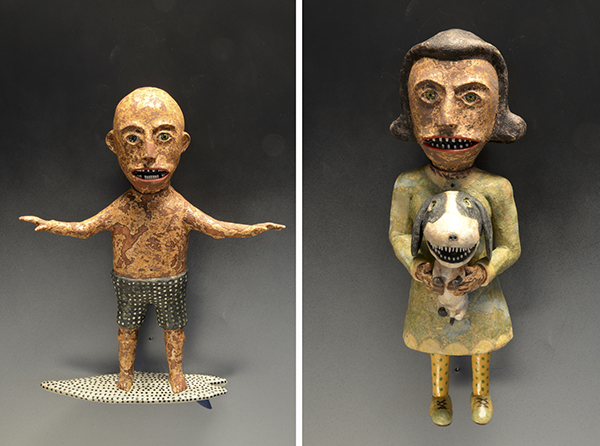
From England, Jennifer Lauren Gallery will introduce the work of Cara Macwilliam and Jesse James Nagel. “They’re both U.K.-based artists who very rarely leave their homes due to their disabilities and they’re both completely self-taught,” dealer Jennifer Gilbert noted. Her itinerant gallery presents exhibitions in various cities in the United Kingdom, and its online “Meet the Collector” series of video interviews and conversations with collectors, dealers, and specialists in art brut and outsider art has grown into an informative, encyclopedic-feeling reference source.
For some viewers, Macwilliam’s drawings in watercolor pencil on paper may suggest affinities with the voluminous line work that can be found in the abstract compositions of certain Japanese art brut artists. Nagel’s drawings, made with oil-based pencils and conventional colored pencils, feature web-like thickets through which strange creatures make their way.
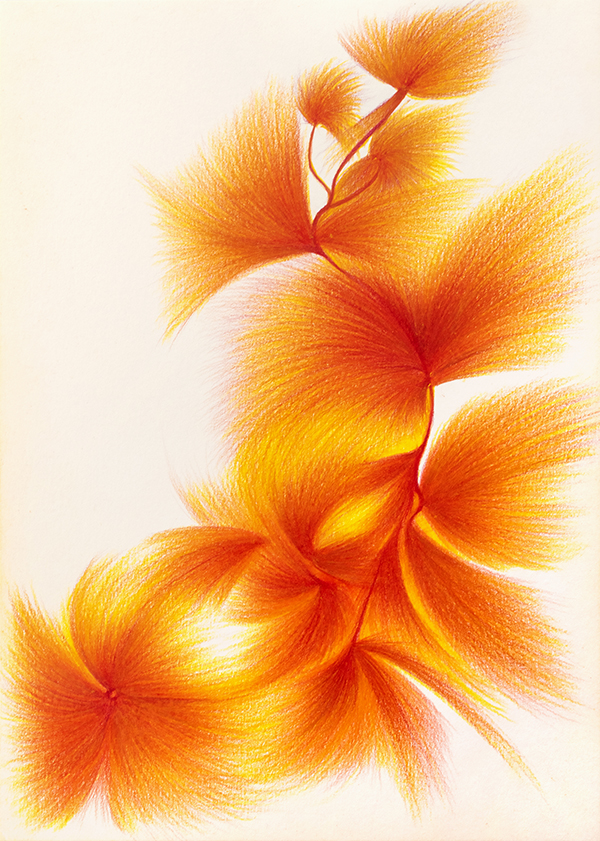
Dealer Aarne Anton is known for American Primitive, his long-running, New York gallery that has focused on works by the most visionary self-taught artists and unusual vernacular objects. But the gallery has vanished into the ether. Anton has decamped and moved full-time online, where he has rechristened his operation “Nexus Singularity” in preparation for the coming sucking-up of everything in the “metaverse” by an enormous black hole somewhere in locationless cyberspace.
In the meantime, at the OAF he’ll show drawings by Daniel Martín Díaz — they resemble scientific diagrams — and by John Henry Toney (1928-2019), an African American artist from Alabama who, legend has it, and as Anton puts it, “one day dug up a turnip in a field and saw a face in it; apparently, the turnip told him to draw, so he made a picture of the turnip.”
Anton added, “The drawing was put in a local shop, and someone bought it. Thus began his art career.”
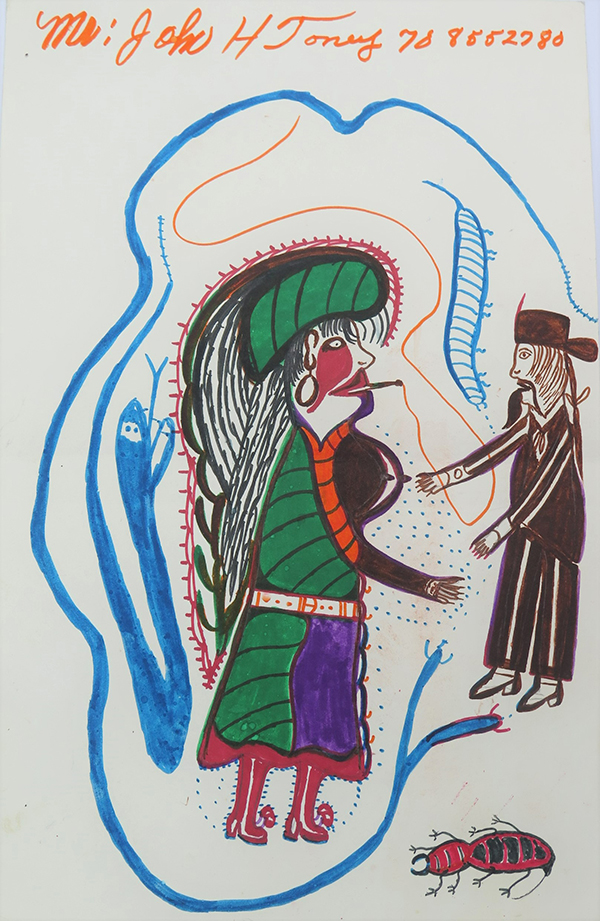
The veteran dealer is also going to give the spirit of his “nexus singularity” concept tangible form. “For as long as I can remember,” he said, “and moreso recently, I’ve been drawn to and I’ve collected art and objects of mystery, often made by anonymous creators. I’ll create one dark wall of these mysteries in my booth — a wall of the unknown, the undefined, the unforgotten.” Those items will lurk, he said provocatively, “behind the door of nexus singularity.” Maybe the entire Outsider Art Fair will be sucked up into a gigantic black hole. Love the expansive thinking of outsider art!
There will be more to savor and discover, to be sure, and brutjournal looks forward to making some big finds of its own.
Randall Morris of Cavin-Morris also shared some thoughts about current developments in the outsider art field, relating them to the role the OAF plays not only as a commercial venue for the presenting and selling of a special kind of art but also as a locus for discussion and debate about it. He said, “As dealers, we continue to curate and show the best we can. The work has always spoken and will continue to speak for itself. What we as dealers can hope for, especially in the U.S., are museum exhibitions and books that will focus on new and living artists of authenticity and importance, instead of constantly rewriting the same tracts about the past and dead artists. We need to move on.”
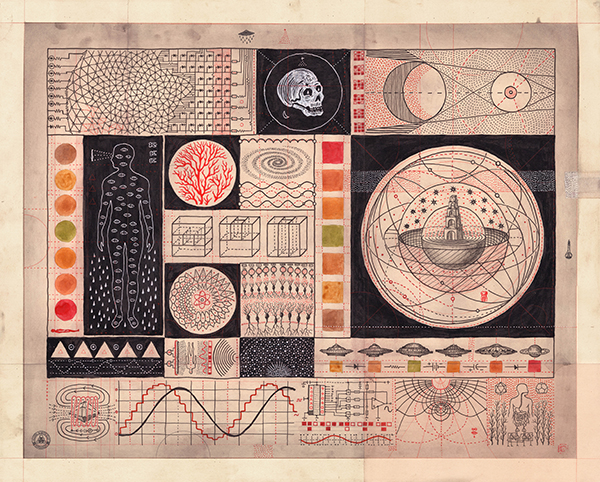
He added, “I feel that we’re at a crossroads. The U.S. does not know enough about non-American art brut, and Europe doesn’t know enough about the global and American work [in the broader outsider field]. We need a period of translation and education to unify the field overall.”
That sounds like an ambitious goal; exactly which players in the outsider art establishment, such as it is today, might be best equipped to help achieve it?
Morris observed, “I’m not sure that [such an effort] will come from the dealers. The tendency at this point is to mash it all together and focus on new or quirky or funny instead of [aiming for] insight and recording the glory and power of the creativity of the human condition” as they have been expressed by talented, visionary, hard-to-classify self-taught artists.
As the Outsider Art Fair appears poised to provide an information-rich — and, as much as possible in the midst of a pandemic, festive — occasion for those who care passionately about the kind of art it showcases, perhaps its promoters and aficionados, looking ahead, will begin to chart some new paths toward understanding its particular history, value, and powerful allure.
Resources
See Edward M. Gómez’s interview with Outsider Art Fair owner-producer Andrew Edlin in brutjournal‘s January 2022 issue here.
Both this earlier article and the current feature, above, are free-access articles available in their entirety to all visitors to the magazine’s website. Feel free to share the links to these articles with your friends and contacts.


